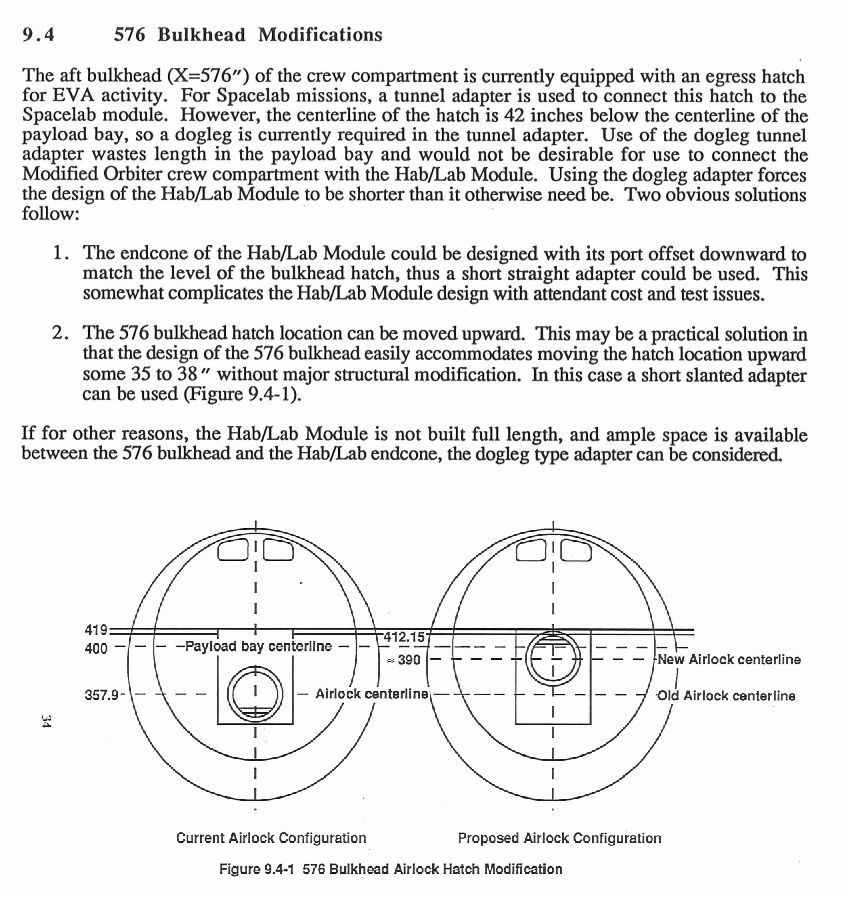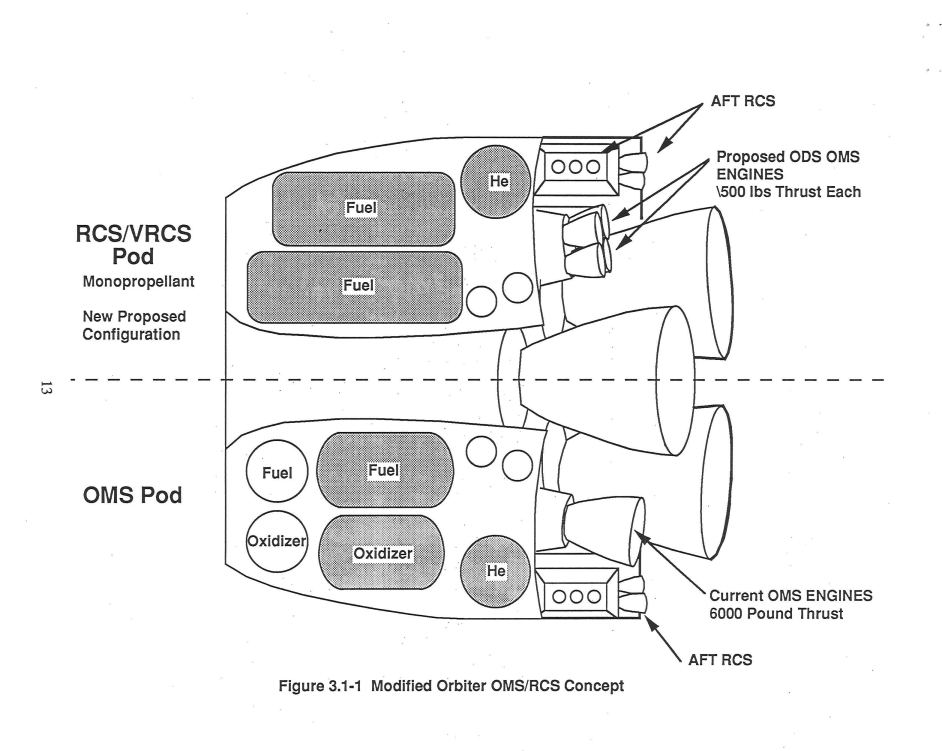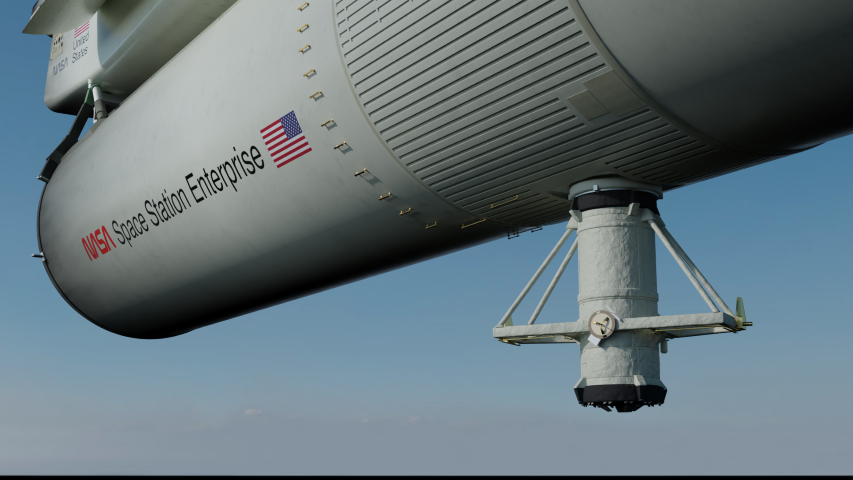Also, on the OMS questions raised by @jsb and @JEF_300 , note that this document at least suggests replacing the main OMS engines and aft RCS with a mono-prop system using 4x 500 lbf engines replacing each 6000 lbf biprop AJ-10. This gives better redundancy and better matches thrust for long term orbital reboost. It's notable the report doesn't quite have the courage of its convictions: the images elsewhere in the document mostly show the normal OMS/RCS setup. If we'd had this earlier, we might have made the change but now with @nixonshead 's renders and the timeline already posting we're not going to. There's enough to argue the flight-proven nature of the existing OMS/RCS setup.
Your approach certainly fits the premise of minimal adaptions for launch as soon as damn possible with also minimal cost of development.
How reasonable would it be to go the other way, and retaining the established main OMS at 6000 versus 500 lbs force (not clear to me if that is per nozzle or overall, but either way we have a factor of 12 higher thrust with the established system) develop dual pipelines, either under high pressure at the core using one central pressurization for main engines and reaction control, or low pressure transmission and some sort of pumped high pressurization at the RC engines, for them to use the same hypergolic bipropellant the OMS main engines use?
This either saves mass for the separate RCS monopropellant tanks and pressurization system, or simply allows larger tankage for the main tanks. I would think that at whatever pressure it is optimal for the small RC thrusters to operate at, using bipropellant hypergol would be as precisely controllable (one has to have dual valves of course, but they can be mechanically yoked together, unless it is desirable to vary the ratios) while more mass efficient. Dual prop hypergol is going to be substantially higher Isp even at modest chamber pressures, and will combust smoothly and reliably at very low throttle settings when firing into vacuum, and with higher Isp the mass flow for a given impulse is significantly lower, whereas one single tank system, of propellants and pressurizing helium, will be easier to design to replenish periodically, and a larger tank set can go longer between refills.
Of course the drawbacks are having to redesign and reinstall dual propellant lines in place of the single lines installed, and needing to design a suitable thrust small bipropellant engine if none happens to be sitting on the shelf in the right range with the right degree of throttling built in. And you know what a bug I am against hypergolics as a general thing (but especially for bulk launch to orbit applications as with Titan II, but thank God that is not in prospect here though it might be for proposals for cheaper methods of replenishment of supplies and possibly crew transfers than Orbiter launches) for various reasons.
I would think most of the OTL monopropellant lines ran through what would be vacuum in OTL Orbiter anyway, whereas I am guessing "monopropellant" means hydrazine anyway, so there is one of those toxic culprits right in the standard Shuttle design. And to my knowledge of all the problems OTL Orbiters had, hydrazine leaks contaminating anything or otherwise doing damage were never among them, versus say the incident wherein the reentering Apollo-Soyuz CM ingested hypergolic attitude control propellants into cabin air in 1975. The whole mess of hypergolics on Orbiter was all aft of the payload bay I suppose though surely there was matching monoprop hydrazine in the nose units, which I guess was all installed outside the pressure shell.
Given that your more conservative design did not consider stuff like removing the standard nose installations, presumably so that reaction control during ascent and maneuvering to parking orbit would proceed with standard control methods, what becomes of that cluster of thrusters once Station Enterprise is fully deployed and operational? I guess it is retained to provide the standard control thrusts just as during launch, which means over months and years the hydrazine and pressurant in the forward module has to have provision to be topped off periodically, as does the standard monoprop tank set(s) in the rear modules. The alternative would be to design and add in some kind of feed lines to top off all five of the fluids--acidic oxidant and hydrazine-variant fuel for the main OMS engines in back, monoprop I presume hydrazine-variant for the sets in back and in front, and pressurant, presumably helium, that might have to be at different highest pressures to refill the separate OMS and RCS tanks. Such a five-line bus (four, if perhaps the RCS and OMS have the same maximum helium pressure) might amount to a lot of weight, but the alternative is resupply having to contact a great many shorter separate lines at both ends.
If a single refuel port for all is preferred, I think that's an argument for consolidating to one system or the other, which would reduce the feed lines to three sets anyway. Of course then we'd need operational pairs of oxidant and fuel lines to the nose RCS complex, or expect to someday soon exhaust this if a standard monoprop system with no orbital refill developed.
---------
Something else I wondered--the narrative remarks on how crucial it is to get the Enterprise's solar panels fully deployed to start generating the higher power draw than an Orbiter normally required, meanwhile having to draw on the visiting Orbiter for spare power. And as OTL with Skylab, if there had been any trouble deploying the limited single panel putting the parked assembly on life support maintenance wattage, the whole station would be in deep trouble.
Now I certainly noticed that early on it was decided to replace Enterprise's main power source as designed, the hydrogen-oxygen fuel cells, with solar panels buffered with batteries, and relying on that long term was sensible. It was remarked that the fuel cells had limited service life before needing to be replaced, not a problem with Orbiter ops but a big one with Station Enterprise which cannot be brought to the surface for refurbishment.
But meanwhile we had the usual hand-wringing about "OMG, how shall we purge the hydrogen fuel tank so we can safely inflate it with breathable air!" If the propellant were hypergolic you know I'd be up on the ceiling clinging with my claws in terror about even slight molar contamination; if it were hydrocarbon, even as simple a molecule as methane, let alone carcinogenic benzene-laced typical kerosene type fuel, I'd worry a lot too.
But it's hydrogen! I've always wondered how overblown such fears are with clean hydrogen, when one can simply open a path from the tank to vacuum. Sure, the last partial traces of hydrogen might take days or weeks to zigzag their drunkard's walk individual molecule ballistic trajectory way to the aperture and thus bouncing along through the vent to open space--but by then we have tiny masses of hydrogen, and if we introduce oxygen most of it will by and by reach thermal chemical equilibrium as water molecules, and meanwhile traces of pure hydrogen are pretty harmless biochemically speaking.
But wait! We have a situation where upon reaching parking orbit, we have propellant residuals in both the LOX and LH tanks, which taken by itself as a problem, we can solve by just opening up to vacuum and venting. (Although, another hassle with that simple solution is that we have very low but palpable cold gas thrusting going on, which would require us either to factor it in to final achievement of parking orbit, if we can vent the gases through the main engines and out the nozzles, or devise some sort of thrust neutral special venting mast or sets of them so that manifold pressure is guaranteed to produce overall neutral, cancelled out thrust). But looking ahead--we don't want to vent the LOX, or at least not all of it, we want to retain the right amount to serve as the partial pressure of oxygen desired in the shirtsleeves gas mix for colonizing the two tanks. What we want to do with it then is add nitrogen, unless SS Enterprise is designed to operate on a different gas mix than Orbiter, which I doubt. Meanwhile we certainly don't want to have trace hydrogen gas in the former LH tank to be sure, but behold--prior to the first crew docking and visit, we need standby power, and have one potential point of failure if that single solar panel does not deploy right.
So if we have substantial amounts of hydrogen in the LH2 tank, and substantial amounts of oxygen ullage in the LOX tank--what if we just kept the standard fuel cells, or a portion of them, and had an auxiliary feed line from the two ET big tanks to bleed gaseous (chilly, I imagine, but evaporated) oxygen and hydrogen to feed the cells? They would generate electricity, and their output "exhaust" would be pure liquid water, which the coming flight crews will be quite glad to have on hand. So now we might get away with not deploying any solar panels at all until there is a docked crew aboard and observing from the visiting Orbiter to supervise. Meanwhile we get the power needed from a fairly foolproof and largely standard setup--the only difference from standard Orbiter ops being that the reactants are trickling in from the main ET instead of auxiliary onboard LOX and LH2 tanks. We might still want the former installed as reserves for the operational crews, but we can omit the latter, which would be bulky and heavy "dry" far out of proportion to the low mass of hydrogen they would have contained. That's 2/3 the tank mass, roughly, if we omit just the LH tanks but leave the LOX in place. Though I imagine actually the Orbiters will carry the oxygen needed for each crewed sortie and we might not need reserve LOX tanks for breathing on Enterprise at all--suspenders and belt redundancy would suggest setting up a rack, brought up on an Orbiter visit, to mount just outside the standard Orbiter bay where a visiting resupply mission can swap it for a charged one and take the empties back to Earth, with a feed line down to the installed built in feed system in Enterprise.
Guessing that the vast ET is going to be filled with 2000 cubic meters of air that is say 2/3 nitrogen and 1/3 oxygen, at 70 percent of Earth sea level standard pressure, we'd have in the ballpark of 700-1000 kg of oxygen, so a single tonne of LOX residual ullage is sufficient, the rest is surplus. How high are tank-line residuals on MECO normally? I'm guessing more than a tonne of LOX! That's to fill both tanks. (We would also need another 2 tonnes or so of nitrogen, brought up I presume in liquid form in a modest portion of the payload of an Orbiter sortie).
At the rate the single life-support standby solar panel provides power on average, how long would it take to react all the oxygen beyond a single tonne remaining in the LOX tank? If there is say 2 tonnes of LOX left over after launch, we would require 1/8 tonne of hydrogen to produce 9/8 tonne of water. And of course if we leave all the fuel cells installed we can use power, and accumulate water, a lot faster than on standby, without having to tap into the visiting Orbiter. Suspenders and belt, we need the solar panels long term anyway, and we might as well deploy the single panel in advance, unless we would rather wait to make the first docking easier.
Once the first crew has come and deployed all the panels, we might find we have not used up all the excess oxygen and surely still have far more hydrogen than we could usefully dispose of, so both tanks would be vented to finish the job of preparation to enter the tanks. But once we've vented down the LOX tank so it contains only the tonne or less we want, we are almost good to go; if meanwhile we let the hydrogen tank drain to near vacuum, correcting any thrust that produces with our fully operational pair of Orbiter maneuvering systems, we can release the majority of the LOX into the hydrogen tank, even if there are still some hydrogen residuals, as long as the concentration of hydrogen would be below flammable limits. Now I know that that concentration is pretty low for hydrogen in oxygen, but it is finite, a matter of a few percents, and surely opening the hydrogen tank via built in fuel feed lines to vacuum will fall below those limits pretty soon. This despite the fact both gases will be cold initially.
If we remain nervous about operating with substantial traces of hydrogen, what about bringing along canisters of catalyst, like platinum foil, and blowing the mix through them? This will result in controlled combustion, heating up the array of catalyst and generating water vapor--which we certainly want in breathable air! Human respiration will by and by raise the humidity to risk being excessive for comfort and safety (we certainly don't want it dripping wet with mold accumulating!) so there must be some method of dehumidifying the air built in, but I don't think the sorts of traces we would have left in the hydrogen tank would come anywhere near this saturation humidity if catalyzed into water.
The slower we take it, the more we can use the built-in fuel cells. In operation, we can route some power toward heating the tanks so we don't need so much power later to raise them from around 200 to close to 300 K. We can warm nitrogen as it expands out of LN2 tanks. The more useful power we extract from the ullage the more potable water we retain too.
Depending on just how much inevitable tank residual mass there is, keeping the fuel cells on line we can perhaps provide far more power to Enterprise prior to the first dock overseeing the full solar panel deployment.
The downside is not saving the mass of the fuel cells for some other thing built in to Enterprise, but overall I think we come out pretty far ahead. We have high power available in the critical period before the first crewed Orbiter can dock and hook up its own power. Instead of venting mass that we perforce had to boost to transfer orbit, we gradually convert it into useful and easily stored water. This means slightly more mass the Enterprise OMS and RCS must nudge into stable parking orbit and thus more propellant used up that way but presumably there is a plan to periodically replace it, whereas most of the residual mass, or anyway much of the LOX that makes up the lion's share of that, is needed to inflate the tank volume later, and venting the excess prior to final orbital insertion would involve as noted disturbing cold gas venting thrusts that need to be compensated to avoid messing up that trajectory anyway. The fuel cells are generally useless once we get to the phase of making the tank mixes breathable, since then we must get rid of any remaining hydrogen (down to acceptable traces). But they are therefore not going to undergo any more wear and tear toward end of useful life, unless they deteriorate when not used somehow, and therefore we have a reserve source of surge power should we decide some future mission requires it, which we can tap by sending up some hydrogen and extra oxygen and connecting these tanks then.
It has been a long time since Archibald, now banned, had his "Save Columbia!" thread, but IIRC the fuel cells are not terribly massive, and we can as noted anyway remove the onboard reactant tanks for that mass saving if we don't intend to use the standard installation of LOX tanks to maintain oxygen levels in Enterprise, and certainly we can omit the hydrogen tanks. I doubt feeds that can deliver the maximum intake the complete standard cell array can take from the ET would be very massive. Overall, how much mass are we talking about saving useful for some other component vitally useful during the initial setup phase of the deployment, by removing the fuel cells?





